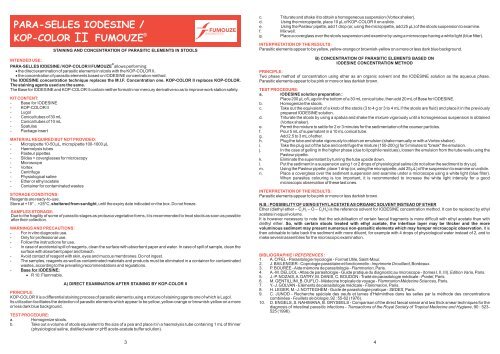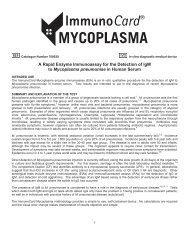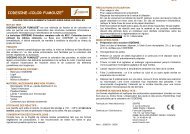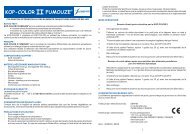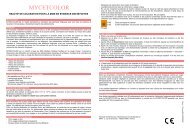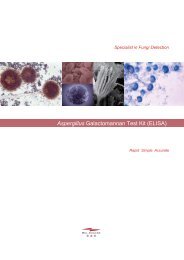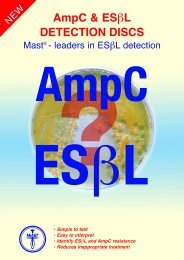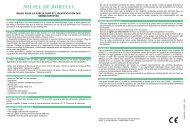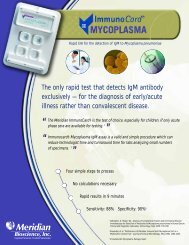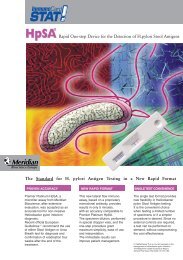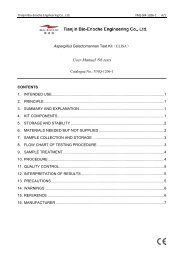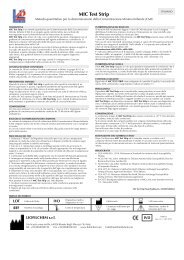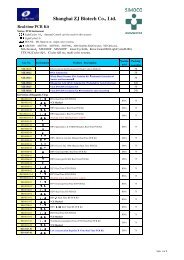para-selles iodesine - Simoco Diagnostics
para-selles iodesine - Simoco Diagnostics
para-selles iodesine - Simoco Diagnostics
You also want an ePaper? Increase the reach of your titles
YUMPU automatically turns print PDFs into web optimized ePapers that Google loves.
PARA-SELLES IODESINE /<br />
KOP-COLOR FUMOUZE<br />
II<br />
STAINING AND CONCENTRATION OF PARASITIC ELEMENTS IN STOOLS<br />
INTENDED USE:<br />
®<br />
PARA-SELLES IODESINE / KOP-COLOR II FUMOUZE allows performing:<br />
the direct examination of <strong>para</strong>sitic elements in stools with the KOP-COLOR II.<br />
the concentration of <strong>para</strong>sitic elements based on IODESINE concentration method.<br />
The IODESINE concentration technique replaces the M.I.F. Concentration one. KOP-COLOR II replaces KOP-COLOR.<br />
The staining agents used are the same.<br />
The Base for IODESINE and KOP-COLOR II contain neither formalin nor mercury derivative so as to improve work station safety.<br />
c. Triturate and shake it to obtain a homogeneous suspension (Vortex shaker).<br />
d. Using the micropipette, place 10 µL of KOP-COLOR II on a slide.<br />
e. Using the Pasteur pipette, add 1 drop (or, using the micropipette, add 25 µL) of the stools suspension to examine.<br />
f. Mix well.<br />
g. Place a coverglass over the stools suspension and examine by using a microscope having a white light (blue filter).<br />
INTERPRETATION OF THE RESULTS:<br />
Parasitic elements appear to be yellow, yellow-orange or brownish-yellow on a more or less dark blue background.<br />
B) CONCENTRATION OF PARASITIC ELEMENTS BASED ON<br />
IODESINE CONCENTRATION METHOD<br />
PRINCIPLE:<br />
Two phase method of concentration using ether as an organic solvent and the IODESINE solution as the aqueous phase.<br />
Parasitic elements appear to be pink or more or less darkish brown.<br />
TEST PROCEDURE:<br />
a. IODESINE solution pre<strong>para</strong>tion :<br />
Place 200 µL of Lugol in the bottom of a 30 mL conical tube, then add 20 mL of Base for IODESINE.<br />
KIT CONTENT:<br />
- Base for IODESINE b. Homogenize the stools.<br />
- KOP-COLOR II c. Take out the equivalent of a knob of the stools (3 to 4 g or 3 to 4 mL if the stools are fluid) and place it in the previously<br />
- Lugol prepared IODESINE solution.<br />
- Conical tubes of 30 mL d. Triturate the stools by using a spatula and shake the mixture vigorously until a homogeneous suspension is obtained<br />
- Conical tubes of 10 mL (Vortex shaker).<br />
- Spatulas e. Permit the mixture to settle for 2 or 3 minutes for the sedimentation of the coarser particles.<br />
- Package insert f. Pour 5 mL of supernatant in a 10 mL conical tube.<br />
g. Add 2.5 to 3 mL of ether.<br />
h. Plug the tube and shake vigorously to obtain an emulsion (shake manually or with a Vortex shaker).<br />
MATERIAL REQUIRED BUT NOT PROVIDED:<br />
- Micropipette 10-50 µL, micropipette 100-1000 µL i. Take the plug out of the tube and centrifuge the mixture (150-200 g) for 5 minutes to "break" the emulsion.<br />
- Haemolysis tubes j. In the case of gelling in the higher phase (due to lipophile residues), loosen the emulsion from the tube walls using the<br />
- Pasteur pipettes Pasteur pipette.<br />
- Slides + coverglasses for microscopy k. Eliminate the supernatant by turning the tube upside down.<br />
- Microscope l. Put the sediment in a suspension using 1 or 2 drops of physiological saline (do not allow the sediment to dry up).<br />
- Vortex m. Using the Pasteur pipette, place 1 drop (or, using the micropipette, add 25 µL) of the suspension to examine on a slide.<br />
- Centrifuge n. Place a coverglass over the sediment suspension and examine under a microscope using a white light (blue filter).<br />
- Physiological saline When <strong>para</strong>sites colouring is too important, it is recommended to increase the white light intensity for a good<br />
- Ether or ethyl acetate microscopic observation of these last ones.<br />
- Container for contaminated wastes<br />
STORAGE CONDITIONS:<br />
Reagents are ready-to-use.<br />
Store at +18°…+25°C, sheltered from sunlight, until the expiry date indicated on the box. Do not freeze.<br />
SAMPLES STORAGE:<br />
Due to the fragility of some of <strong>para</strong>sitic stages as protozoa vegetative forms, it is recommended to treat stools as soon as possible<br />
after their collection.<br />
INTERPRETATION OF THE RESULTS:<br />
Parasitic elements appear to be pink or more or less darkish brown.<br />
N.B.: POSSIBILITY OF USING ETHYL ACETATE AS ORGANIC SOLVENT INSTEAD OF ETHER<br />
Ether (diethyl ether – C2H 5 – O – C2H 5) is the reference solvent for IODESINE concentration method. It can be replaced by ethyl<br />
acetate in equal volume.<br />
It is however necessary to note that the solubilisation of certain faecal fragments is more difficult with ethyl acetate than with<br />
diethyl ether. So, with certain stools treated with ethyl acetate, the interface layer may be thicker and the more<br />
voluminous sediment may present numerous non-<strong>para</strong>sitic elements which may hamper microscopic observation. It is<br />
WARNINGS AND PRECAUTIONS:<br />
- For in vitro diagnostic use. then advisable to take back the sediment with more diluent, for example with 4 drops of physiological water instead of 2, and to<br />
- Only for professional use. make several assemblies for the microscopic examination.<br />
- Follow the instructions for use.<br />
- In case of accidental spill of reagents, clean the surface with absorbent paper and water. In case of spill of sample, clean the<br />
surface with absorbent paper and bleach.<br />
- Avoid contact of reagent with skin, eyes and mucous membranes. Do not ingest.<br />
BIBLIOGRAPHIE / REFERENCES :<br />
- The samples, reagents as well as contaminated materials and products must be eliminated in a container for contaminated 1. A. O'FEL - Parasitologie mycologie - Format Utile, Saint-Maur.<br />
wastes, according to the prevailing recommendations and regulations.<br />
2. J. BAILENGER - Coprologie <strong>para</strong>sitaire et fonctionnelle - Imprimerie Drouillard, Bordeaux.<br />
- Base for IODESINE:<br />
3. P. BOURÉE - Aide mémoire de <strong>para</strong>sitologie - Flammarion, Paris.<br />
4. A.-M. DELUOL - Atlas de <strong>para</strong>sitologie - Guide pratique du diagnostic au microscope - (tomes I, II, III). Edition Varia, Paris.<br />
R 10: Flammable. 5. J.-P. NOZAIS, A. DATRY, M. DANIS, C. BOUDON - Traité de <strong>para</strong>sitologie médicale - Pradel, Paris.<br />
6. M. GENTILLINI, B. DUFLO - Médecine tropicale de voyage - Flammarion Médecine Sciences, Paris.<br />
A) DIRECT EXAMINATION AFTER STAINING BY KOP-COLOR II 7. Y.-J. GOLVAN - Eléments de <strong>para</strong>sitologie médicale - Flammarion, Paris.<br />
TEST PROCEDURE:<br />
a. Homogenize stools.<br />
b. Take out a volume of stools equivalent to the size of a pea and place it in a haemolysis tube containing 1 mL of thinner<br />
(physiological saline, distilled water or pH5 aceto-acetate buffer solution).<br />
®<br />
8. H. LEGER, M.-J. NOTTEGHEM - Guide de <strong>para</strong>sitologie pratique - SEDES, Paris.<br />
9. C. JUNOD - Recherche spéciale des oeufs et larves d'Helminthes dans les <strong>selles</strong> par la méthode des concentrations<br />
PRINCIPLE:<br />
KOP-COLOR II is a differential staining process of <strong>para</strong>sitic elements using a mixture of staining agents one of which is Lugol. combinées - Feuillets de biologie, 92 : 55-62 (1976).<br />
Its utilization facilitates the detection of <strong>para</strong>sitic elements which appear to be yellow, yellow-orange or brownish-yellow on a more 10. D. ENGELS, S. NAHIMANA, B. GRYSEELS - Comparison of the direct faecal smear and two thick smear techniques for the<br />
or less dark blue background.<br />
diagnosis of intestinal <strong>para</strong>sitic infections - Transactions of the Royal Society of Tropical Medecine and Hygiene, 90 : 523-<br />
525 (1996).<br />
3 4


